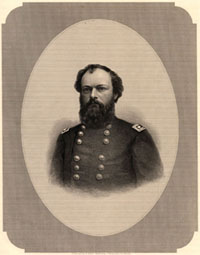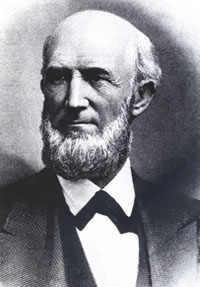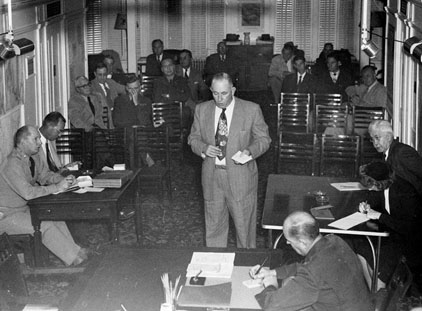Following several decades of Constitutional squabbles, engineering disputes, and regional bickering dating back to the early 1800s, Congress recognized the need to harmonize river improvements on the Mississippi River through a central organization. On June 28, 1879, the federal legislature, assisted by the efforts of a congressional coalition of navigation and flood-control interests, established the Mississippi River Commission (MRC) as an executive body reporting directly to the Secretary of War.
The legally mandated membership of the MRC called for three officers from the U.S. Army Corps of Engineers, one member from the U.S. Coast and Geodetic Survey (now the National Oceanic and Atmospheric Administration), and three civilians—all appointed by the president and confirmed by the U.S. Senate. This splendid mix of membership reflected a desire to heal a burgeoning schism between the military and civilian engineering communities epitomized by the famous clashes between Brigadier General Andrew A. Humphreys, the Chief of Engineers, and James B. Eads, the internationally renowned civilian engineer and original member of the MRC.
The next five decades marked an era of experimentation. Relying heavily on input from local partners and hampered by fiscal and legal constraints, the MRC retreated into a controversial position that an adequate levee system, void of costly adjuncts, could protect the Mississippi Valley from inundation. The first flood control act, passed in 1917, facilitated the final implementation of a doomed levees-only program. Ten years later, the great Mississippi River flood of 1927 forced a wholesale reappraisal of the MRC’s levee policy that resulted in a comprehensive river improvement plan that included tributary basin improvements, channel stabilization, and floodways in addition to levees.
 |
|
 |
|
Bvt, Maj, Gen, Quincy Adams Gillmore
|
|
James Buchanan Eads |
The originating legislation granted the MRC extensive jurisdiction on the Mississippi River from its headwaters at Lake Itasca to the Head of Passes near the Gulf. The act also empowered the MRC to make surveys and investigations necessary to prepare plans to improve the river channel, protect the banks, improve navigation, prevent destructive floods, and promote commerce—perhaps the most difficult and complex engineering problem ever undertaken by the federal government up to that time.
In addition to its responsibilities for overseeing the improvement of the Mississippi River, the newly established MRC gave Mississippi Valley interests a greater voice in shaping federal policy—a tradition that continues to this day. Thus, the practice of addressing issues and concerns through the formal public hearing process, so critical in the federal government’s civil works mission today, began in the Mississippi Valley with the creation of the MRC.
Today the MRC oversees the implementation of the comprehensive Mississippi River and Tributaries (MR&T) project under the supervision of the Chief of Engineers. The MR&T project is arguably the most successful civil works project ever initiated by Congress. Since 1928, the nation has contributed nearly $12 billion towards the MR&T project and has received an estimated $425.5 billion return on that investment, including savings on transportation costs and flood damages. No project levee has ever failed despite several major floods since the inception of the project. Subsequently, the frequency of flooding in protected areas has declined, resulting in a sharp drop in flood damages.
 |
| A resident of the lower Mississippi valley addresses the MRC onboard the steamer Mississippi, the flagship of the MRC, 1954. |
* * *
June 2004